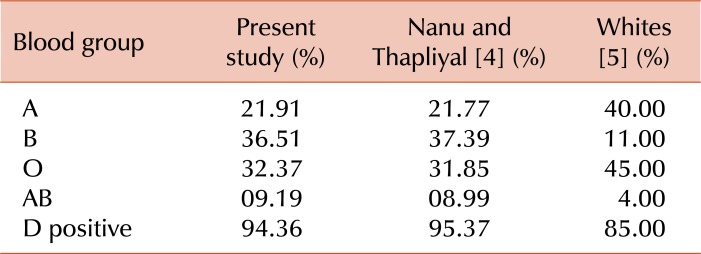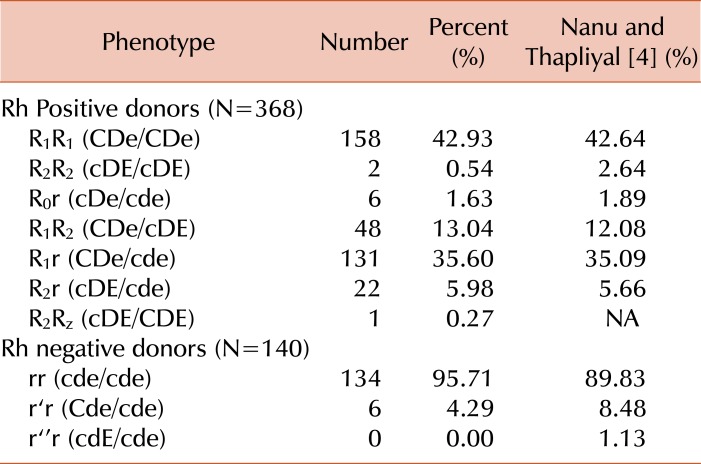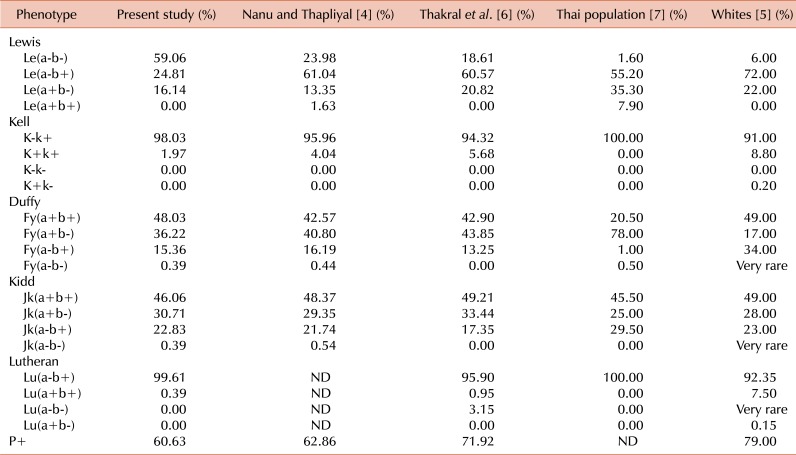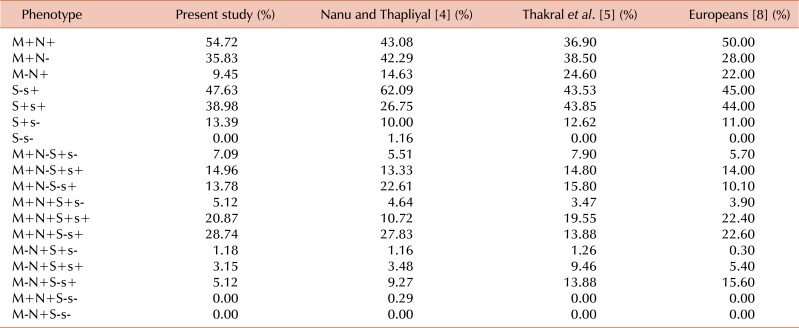Knowledge about the frequency of red blood cell-antigen phenotypes in a population can be helpful in the creation of a donor data bank for the preparation of indigenous cell panels and for providing antigen-negative compatible blood to patients with multiple alloantibodies.
ABO and RhD blood grouping was performed on 9,280 continuous voluntary and replacement donors. For other rare blood groups, 508 ACD blood samples were obtained from the donors at the Blood Bank of the Department of Transfusion Medicine, All India Institute of Medical Sciences (AIIMS), New Delhi, India. Blood group antigens were determined by tube method using anti-sera (Bio-Rad, USA), and the phenotype frequencies were expressed as percentages.
Group B (37.39%) was the most common, followed by group O (31.85%). R1R1 and rr were the most common phenotypes amongst Rh positive and Rh negative groups, respectively. A rare phenotype R2Rz was found in one donor. For Kidd and Duffy blood group systems, Jk (a+b+) and Fy (a+b+) were the most common phenotypes (46.06% and 48.03%, respectively). The most common phenotypes for MNSs, Lu, and Kell blood groups were M+N+, S-s+, Lu (a-b+), and K-k+, respectively. A very rare case of Fy (a-b-) and Jk (a-b-) was found in a single donor.
This study is the first small step to create a rare donor data bank and to prepare indigenous cell panels to provide compatible blood to all multi-transfused alloimmunized patients.
Since the discovery of the ABO blood group by Landsteiner, different blood typing systems have been devised. Blood group antigens are integrated parts of the red blood cell (RBC) membrane and have many essential functions (membrane transporters and protein canals, ligand receptors, adhesion molecules, enzymes, and structural proteins). These surface antigens also have different biochemical compositions [
According to The International Society of Blood Transfusion (ISBT), there are 287 antigens within the 33 blood group systems and 42 antigens in Collections (low and high incidence antigens) [
Although blood transfusions can be life saving for a number of patients, they are not without risks. In addition to risks such as transfusion-transmissible diseases (TTD) caused by donor viruses, parasites, or bacterial contaminants of blood products, there is also a risk of alloimmunization due to donor-recipient antigen phenotype disparity. Still, RBCs for blood transfusion are mostly only matched for the major antigens, ABO and D, an approach that is considered safe and cost-effective, except in chronic transfusion recipients (e.g. thalassemia), who additionally require extended matching for minor antigens.
Proper selection of mandatory and additional blood grouping tests should consider the local needs based on the local antigenic profile and pathology of the population. Antigenic frequencies in Indian donors differ from the widely available data of European and American countries. Thus, the aim of this study was to tabulate regional blood group antigenic frequencies.
ABO and Rh blood grouping was performed on 9,280 continuous voluntary and replacement donors present at the blood bank to donate. For other rare blood groups, 508 ACD blood samples were obtained from the donors at the Blood Bank of the Department of Transfusion Medicine, All India Institute of Medical Sciences (AIIMS), New Delhi, India. This study was performed on 430 men and 78 women (age range, 18-55 years). Most of the donors hailed from Delhi (India) and surrounding states and represented the north Indian population.
ABO and RhD groups were determined using QWALYS 3 (DIAGAST, France), a fully automated and high-throughput system that uses EM technology. Rare blood group antigens were determined in a blood transfusion organization center by tube method using kits supplied by Bio-Rad, USA. Antigens in the main blood group systems, including ABO, Rh (D, C, E, c, and e antigens), MNSs (M, N, S, and s antigens), Lutheran (Lua and Lub antigens), P1 antigen, Kell (K, k antigens), Lewis (Lea and Leb antigens), Duffy (Fya and Fyb antigens), and Kidd (Jka and Jkb antigens) were identified. According to manufacturer's instructions, antigens were typed either directly by adding antisera to 3-5% of donor RBC suspensions or indirectly by using an indirect antiglobulin test. Positive and negative control cells and Coombs' control cells were used as quality controls.
We determined minor blood group antigens in 508 donors composed of 87.4% male and 12.6% female donors, who were in the age range of 18-55 years.
The distribution of ABO and Rh blood groups is shown in
All donors were positive for Lub, while Lua was present only in 1 donor. In the MNS blood group system, 35.83% of donors were homozygous for the M antigen and only 9.45% was homozygous for the N antigen. M+N+ was the most common phenotype observed. Furthermore, S-s+ was common (47.63%) and overall, M+N+S-s+ was the most common phenotype (28.74%).
In this study, we examined the composition of RBC antigens in north Indian blood donors. A similar study by Nanu and Thapliyal [
In this study, B was the most common blood group followed closely by the O group. This finding is in concordance with other studies published from India [
The Rh blood group system is the most polymorphic and, next to ABO, is the most clinically significant blood group in transfusion medicine [
The phenotype frequencies in Kell, Kidd, and Duffy systems confirmed the findings from other previous Indian studies [
In contrast to other studies from India, among the four phenotypes of Lewis (Le) blood group, the Le(a-b-) was found to be most frequent. Twp previous studies from India have reported Le(a-b+) as the most common phenotype [
Lu(a-b+) was the most common phenotype (99.6%), which is true for most of the populations around the world. Lu(a+b+) was reported in one donor, which is not surprising, given its rare occurrence in the Indian population.
In the MNs blood group system, M+N+ was found to be more frequent than that reported in other studies. These studies have found M+N- to be almost equal or more frequent than the M+N+ phenotype. The phenotype frequency of S-s+ was the most common and comparable to that reported by Thakral et al. [
In conclusion, we observed differences in the phenotype frequencies reported in previous studies from India. Specifically, a high frequency of Le(a-b-) was observed as were one donor of each of the rare phenotypes R2Rz, Jk(a-b-), and Fy(a-b-).
No potential conflicts of interest relevant to this article were reported.
ABO and D blood group distribution (N=9,280).

Rh phenotypes frequency in north Indian donors.

Phenotype frequencies of Lewis, Kell, Kidd, Duffy, and Lutheran blood group systems (compared to other published data).

Abbreviations: K, Kell; Fy, Duffy; Le, Lewis; Jk, Kidd; Lu, Lutheran; ND, not done.
Phenotype frequencies of MNSs blood group system (Compared to other published data).
